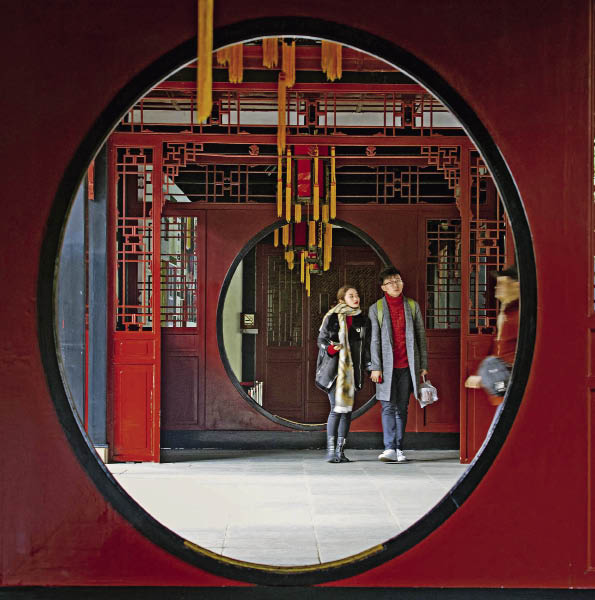

Wuhou Memorial Temple, a landmark of Chengdu.
CHENGDU is the capital of Sichuan Province in southwestern China, boasting a history of over 2,300 years. With rich natural resources and developed agriculture, it was the main source of grain and revenues of the central regime in ancient times. It is also the home of the world’s earliest paper money – Jiaozi.
Chengdu is blessed with both cultural splendor and natural charm. It is the hometown of Du Fu (712-770), lauded as the sage of poetry, the Chuan Opera, which is best known for its magical mask-changing skill, Shu brocade, Shu embroidery, as well as Sichuan cuisine. For wildlife lovers, Chengdu is the natural habitat of the endangered giant panda.
A benign climate, a rich history, abundance of resources, and a life of ease and tranquility all make Chengdu a city that will win your heart and mind. Once you have experienced its charms you may never want to leave.
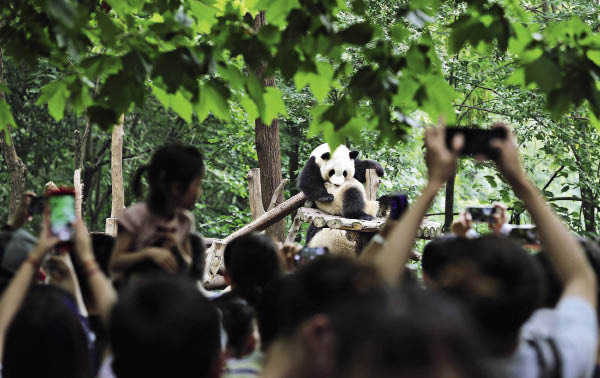
A giant panda at the Chengdu breeding base on April 30, 2018.
The World’s Oldest Water
Conservation Project
The Minjiang River, a tributary of the Yangtze, is the largest source of water in Chengdu. It rushes down from the Minshan Mountain in the west to the Chengdu Plain 273 meters below. In ancient times, the city was prone to flooding in spring and summer due to its low altitude when the water flowed in raging torrents. In the dry season, however, drought was a regular problem. In 256 BC, local governor Li Bing started an eight-year project to carve through the Yulei Mountain and build the irrigation system Dujiangyan.
Taking advantage of the sloping terrain that is higher in the northwest and lower in the southeast, Dujiangyan harnesses the river by dividing water, reducing silt, and controlling the flow. It effectively alleviated floods and facilitated irrigation of local farmlands, hence significantly boosting Chengdu’s economy.
Dujiangyan is still functioning 2,000 years after construction, the only functioning irrigation system that was built in ancient times in the world. It is an outstanding example of humankind’s exploitation of nature without damaging it, and stands for the harmony and unity between humankind and nature. In 2000, Dujiangyan was named a UNESCO World Heritage Site.
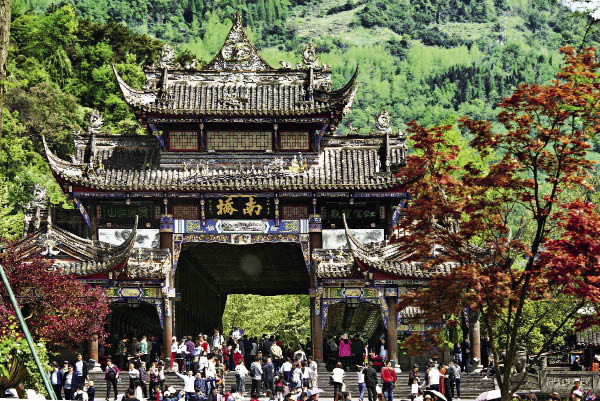
The South Bridge of Dujiangyan.
Capital of the Shu Kingdom
Chengdu was the capital of regional regimes for millennia. One of them was the state of Shu of the Three Kingdoms Period (220-280) founded by Liu Bei (161-223) in 221. The story of Liu Bei and his supporters is known to every Chinese household thanks to the classic novel Romance of the Three Kingdoms.
In the late years of the Eastern Han Dynasty (25-220), the power of the central authority was eroded by rising warlords across the country. After a period of prolonged warfare, three of these warlords were victorious. They went on to establish three rival kingdoms. The kingdom founded by Liu Bei, named Shu, occupied southwestern China, including today’s Yunan, Sichuan, and Guizhou provinces.
On the foundation of developed agriculture and a handicraft industry, especially silk production, the region soon established a vibrant commodity-based economy. Historical records say that the city teemed with shops selling a great variety of goods, including those rare in China. Though wars were frequent, the Shu economy and society escaped destruction.
In the centuries that followed, Chengdu grew into a metropolis with a booming economy and culture that matched Chang’an (today’s Xi’an), and Luoyang, both capitals of several dynasties. In 1023, the world’s first paper money, Jiaozi, was officially issued in Chengdu, a testimony of the advanced economy in the region.
Physical remnants of the Three Kingdoms period abound in Chengdu, and anecdotes of warriors and strategists of that time are still fondly remembered and passed down generations. History is alive here on the age-old bridges, in the twisting lanes, and in traditional teahouses.
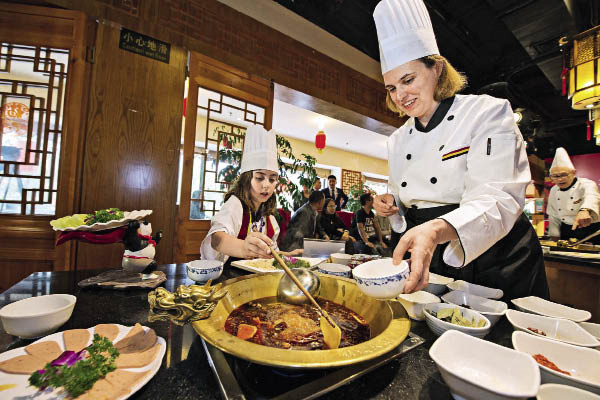
A hotpot contest for international chefs held in Chengdu on April 25, 2018.
Habitat of Giant Pandas
In the spring of 1869, French missionary Armand David encountered a black and white animal, which he named the black-and-white bear. He later sent this specimen for display in Paris, introducing this rare animal to the West for the first time.
Fossils show that giant pandas first appeared on earth two to three million years ago, and their population peaked hundreds of thousands of years ago when their habitats covered most territories of eastern and southern China. All other animals descending from that age are now extinct, but the giant panda has survived, which earns it the epithet a “living fossil.” Its habitat has however shrunk to the Qinling Mountain in Shaanxi Province and the Minshan Mountain at the border of Sichuan and Gansu provinces. Sichuan is a haven for this endangered animal.
In the 1980s, Fargesia rufa, a woody bamboo and major source of food for the giant panda, died after flowering in certain parts of Sichuan, leaving many giant pandas facing starvation. Some had to be taken to the Chengdu Zoo. For better protection of this rare animal, Chengdu established a breeding base in 1987. Over the past 30 years it has made technological breakthroughs in such fields as artificial breeding, reproduction, disease treatment and prevention, and population genetics, and expanded the number of giant pandas in its care from six to more than 100.
The facility is open to visitors. It mimics the natural environment, with artificial lakes, rivers, bamboo forests, and lawns. The built up areas include a section for pregnant pandas and new-borns and air-conditioned enclosures with attached gardens for pandas. Visitors can observe these adorable animals playing outdoors in cool weather or watch them through glass walls during hot days.
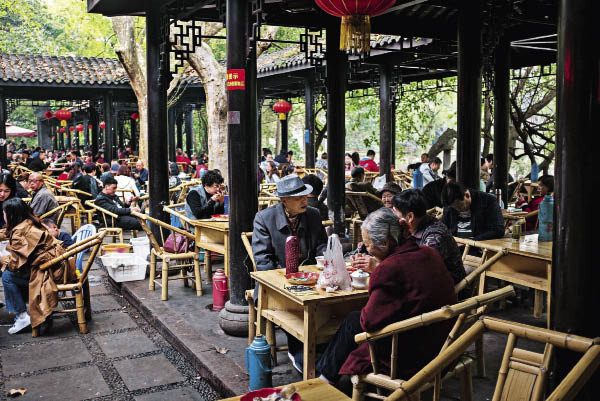
A teahouse in the People’s Park in Chengdu is filled to capacity on March 23, 2018.
Slow-Paced Life
The pace of life in Chengdu is much slower than in other big cities in China. Locals spend long hours in the teahouses, playing mahjong, or watching story-telling performances.
The teahouse is a symbol of Chengdu, ubiquitous on streets, in parks, under bridges, and next to historic sites. Most of them are packed to capacity much of the day. With bamboo chairs, the three-piece tea ware and waiters who can balance a stack of dozens of cups and expertly fill the cups from a distance with long-necked kettles, the teahouse is the best place to savor traditional Chengdu ambiance.
Chengdu people love to eat, and the city is heaven for foodies, with restaurants serving dainty dishes and snacks around every corner. Popular all over China, the spicy Sichuan cuisine is in fact highly nuanced in flavor because of the team-up of cayenne pepper, Sichuan pepper, black pepper, and a multitude of other condiments. The ingredients are common in Chinese diet, another reason that Sichuan food appeals to people of different social strata and regions.
Chengdu cuisine belongs to the Shanghebang, one regional style of Sichuan cuisine. It features a wider variety of condiments, lighter taste, and more emphasis on the old tradition, and is the most loved of all Sichuan cuisine. The list of its signature dishes is long, and new inventions over recent years have also gone viral. In 2010, Chengdu joined the UNESCO creative cities network as a renowned center of gastronomy.
(Complied by China Today)